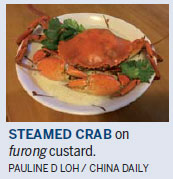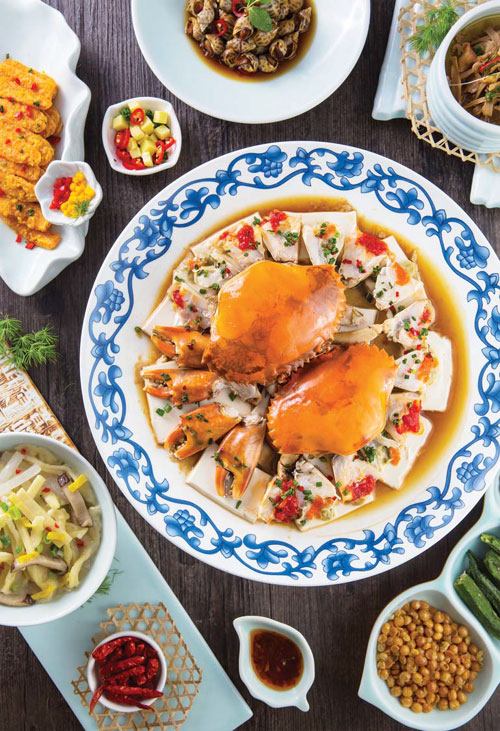Claws for thought
Updated: 2016-09-23 08:01
By Pauline D Loh(China Daily Europe)
|
|||||||||
Editor's note: To understand China, sit down to eat. Food is the indestructible bond that holds the whole social fabric together and it is also one of the last strong visages of community and culture.
Autumn means the bright red of green crabs for many Chinese gourmets
Rich hues decorate the autumn table with its seasonal squashes, gourds, melons, corn, tomatoes, peppers, chestnuts, pomegranates and persimmons. These colors all form a warm glowing palette.
|
There are many ways to cook Sanmen green crabs, with steaming preferred to keep the natural sweetness. Rui Yi / For China Daily |
In China, the jeweled spectrum becomes even more vibrant with the rich red of crabs.
Autumn is the time to feast on crabs from the seas, rivers and lakes. This is the season when they have fattened up for mating and are rich with roe and milt.
Many gourmets equate autumn with hairy crabs, the unique Chinese mitten crabs that have become a growing food fad both at home and abroad, and whose prices skyrocket each year.
These little freshwater crabs need to be delicately dissected to get at the meat, but the main attraction is the spoonful of fragrant roe at the heart of the creature.
Less well known, perhaps, but equally delicious is the local mud crab or green crab. They live in the brackish waters near river mouths along the coast, from the eastern seaboard right down to the Pearl River Delta in Guangdong province.
The best green crabs are from Sanmen Bay in central Zhejiang province, where the catching and cultivation of these creatures have been going on since the 17th century.
Each crab can weigh in at 500 grams or larger, and during September and October, females are heavy with roe while males fatten up to do battle. A single claw on the male can be as large as a baby's fist.
In the tropical monsoon climate of these regions, the crabs are available almost year-round, except in winter when they hibernate. They are still most in demand when the weather is cooler and the chrysanthemums are blooming.
Sanmen green crabs have been getting increasing attention from seafood lovers in China, mainly thanks to two factors - online sales platforms and efficient logistics.
Bao Jianghui, 24, is one of the young entrepreneurs who have taken advantage of both aspects to revive his family's farming business. He has a well-rated online shop that sells green crabs. His grandfather started rearing crabs, and his father continued the tradition.
After Bao graduated from college, he decided to join the family business and began a marketing strategy his grandfather and father would never have dreamed of.
"First, you have to create a presence online," he says. "The web is a powerful marketing tool and is far-reaching. You get many repeat customers if your products and services are up to expectations."
Sophisticated logistic support also means that the crabs can reach customers within a day to 36 hours almost anywhere in the country - and still be very much alive. That is crucial because no Chinese would ever eat a dead crab.
Crab farms in Sanmen have been around for more than 200 years. In the beginning, fishermen caught crabs just as they were molting and defenseless, and kept those they could not finish eating in earthen crocks buried in the mud flats.
Later, they dug holes in the mud to attract crabs looking for ready-made homes. For protection, the fishermen would cover the holes with stone slabs.
It was not until the 1980s that dedicated crab farms were established with government support for research and development. Today, the crabs can be reared from larvae to maturity, and there are more than 6,000 hectares in Sanmen devoted to crab farming.
Two in every 10 green crabs sold in China comes from Sanmen.
These crabs are as hearty as the freshwater mitten crabs are delicate - both in size and flavor. They are no less expensive, though, because a 400- to 500-gram crab can cost up to 200 yuan ($30; 28 euros), with free courier delivery for a minimum order of two.
There are many ways to cook the meaty crustaceans, with steaming preferred to keep the natural sweetness. Even so, they are steamed with scallion and ginger to dispel any fishy smell, or steamed in wine to enhance their fragrance.
A more sophisticated recipe involves sitting a whole dressed crab on wine-flavored egg white custard.
As more Chinese travel abroad, they are also experiencing crabs in new ways, including the delightful Southeast Asian crab smothered in chili, or black pepper crab, curried crab and crab salad.
Most of all, a crab feast in autumn speaks of seasonal freshness, of an ambience scented by golden and bronze chrysanthemums, of fulfilling the body's need for protein-rich foods as we gird our loins for the coming winter chill.
paulined@chinadaily.com.cn
Recipes to try
Steamed crab on furong custard
1 large green female crab, about 500 grams
2 egg whites, lightly beaten
Half cup chicken broth
1 teaspoon Chinese cooking wine
1 teaspoon salt
Kill, clean and dress the crab, removing the gills and scrubbing the shell well. Chop into eight pieces and crack the claws for easier eating.
Combine the egg white together with the chicken broth, wine and salt, and pour into a wide platter deep enough to hold the custard mixture. Arrange the crab pieces on top. Steam over high heat for 20 to 30 minutes. Rest for a few minutes and serve.
This is a wonderfully colorful dish with the white custard acting as a canvas for the red crab and its bright orange roe.
Black pepper crab
1 large crab, male or female, about 400 to 500 grams

3 tablespoons freshly cracked black pepper
2 tablespoons honey
200 grams butter
Salt to taste
Clean and dress the crab, removing the gills and scrubbing the shell. Chop into eight pieces. Crack the claws.
Heat up a wok with one cup of oil and deep-fry the crab pieces to seal in the juices. This should take about five minutes or less. Drain the crab and discard the oil.
In a clean wok, melt the butter and add the cracked black pepper. Add the crab pieces and toss to coat completely. Drizzle with honey, and toss again to mix.
Serve immediately with steamed rice or bread to sop up the juices. It's a pretty high-octane dish. You can turn down the heat with less pepper, but it will lose its spicy kick.
(China Daily European Weekly 09/23/2016 page18)
Today's Top News
ODI led for first time by private firms
Nanjing's culture and creativity on display in London
State of emergency declared in US city amid protests
Universities given boost in rankings
Demand for Mandarin rises in UK
China 'capable of keeping medium-to-high growth'
Li tells Obama of opposition to THAAD deployment
Greek vows to improve refugee situation on island
Hot Topics
Lunar probe , China growth forecasts, Emission rules get tougher, China seen through 'colored lens', International board,
Editor's Picks

|

|

|

|

|

|








